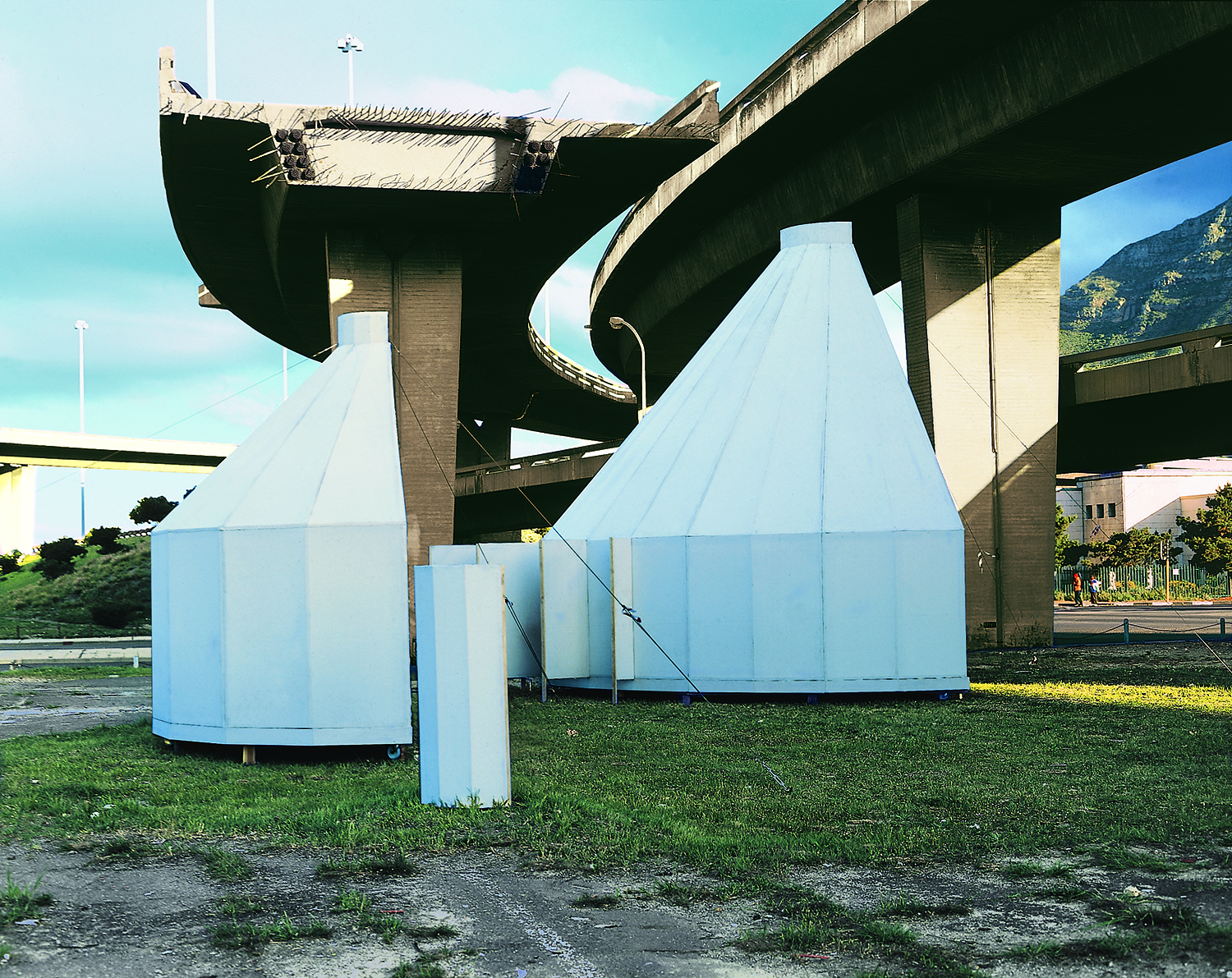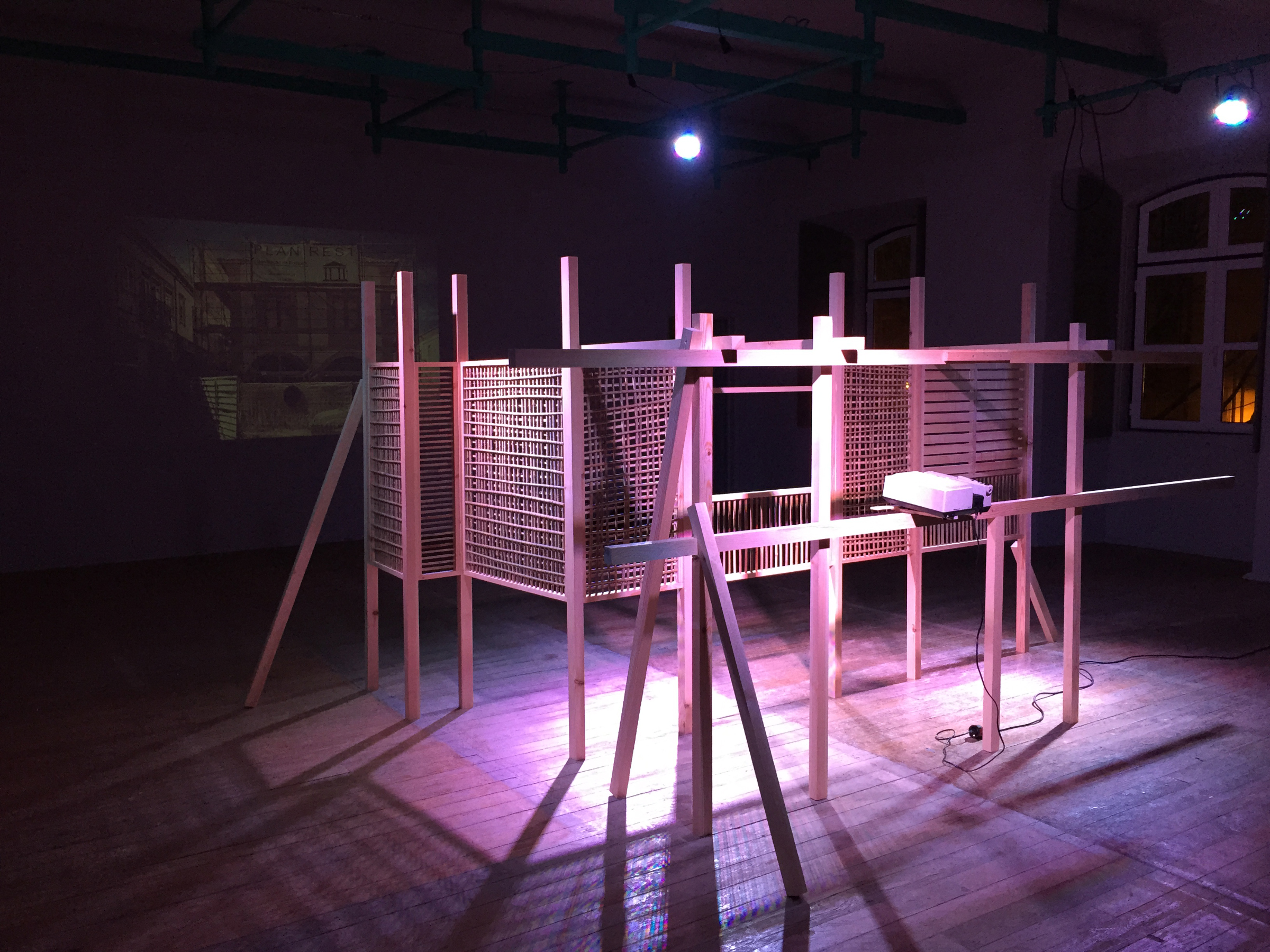 Ângela Ferreira’s “Zip Zap Circus School” references unrealized projects by architects Mies van der Rohe and Pancho Guedes. It will be on display at the DePaul Art Museum as part of the 2017 Chicago Architecture Biennial. (Image courtesy of the artist)
Ângela Ferreira’s “Zip Zap Circus School” references unrealized projects by architects Mies van der Rohe and Pancho Guedes. It will be on display at the DePaul Art Museum as part of the 2017 Chicago Architecture Biennial. (Image courtesy of the artist)
CHICAGO
— Architecture, art and history will intersect this fall at the DePaul Art
Museum in “Ângela Ferreira: Zip Zap and Zumbi.” Museum Director and Chief Curator Julie Rodrigues
Widholm will organize the artist’s first U.S. solo
exhibition in conjunction with the Chicago Architecture Biennial. The
exhibition runs Sept. 7 through Dec. 10, 2017.
Ferreira’s
work mines the complex historical relations that link African indigenous
culture, slavery and European modernism. In this exhibition, Ferreira will
bring together two projects that were never built: Mies van der Rohe's 1913 commission
to construct a private museum and house in the Netherlands; and Portuguese architect Pancho Guedes' 1990s design for Zip Zap Circus School in Cape Town,
South Africa. The exhibition includes documentary photographs, architectural
drawings and a physical structure, which will become a platform for
performances and community gatherings.
"Mies
van der Rohe's modernism is synonymous with Chicago architecture,” said Widholm.
“Ângela Ferreira's work offers a unique post-colonial
perspective on this familiar subject, while connecting Chicago to a global
conversation around the history and politics of architectural forms and
materials," Widholm added.
In the heart
of DePaul University’s Lincoln Park Campus, the museum will serve as an anchor
site for the 2017 Chicago Architecture Biennial. Ferreira's
research-based investigations tap into the biennial theme, “Make New History.”
"Ferreira's work as an artist allows us to consider the complicated
relationship between art, architecture and social concerns in order to write
new histories," said Widholm.
About the exhibition and artist
“Zip Zap Circus
School” references two unrealized projects by modern architects van der Rohe and
Guedes. Set in a highly politicized and socially explosive South Africa of the
end of the 20th century, Ferreira uses sculptural and architectural
materialization to comment on architecture as a catalyst for social change. By
building a portion of Guedes’ architectural project as an artwork, the artist
rendered the idea of the architect’s dream as a political act.
 Ângela Ferreira’s “Wattle and Daub” incorporates a sculptural screen and a structure and references a traditional African and Brazilian building technique. It will be on display at the DePaul Art Museum as part of the 2017 Chicago Architecture Biennial. (Image by Vera Marmelo, courtesy of the artist)
Ângela Ferreira’s “Wattle and Daub” incorporates a sculptural screen and a structure and references a traditional African and Brazilian building technique. It will be on display at the DePaul Art Museum as part of the 2017 Chicago Architecture Biennial. (Image by Vera Marmelo, courtesy of the artist)The installation “Wattle and
Daub” uses a slide projection to depict a building once used as a slave market
in the 15th century in Lagos, Portugal. Standing before the image is a sculptural
screen constructed according to a traditional African and Brazilian building
technique known as wattle and daub. With a soundtrack of a performer singing
Jorge Ben Jor’s “Zumbi,” the work
evokes the memory and power of the escapee slave communities in Brazil through
the image of charismatic leader Zumbi dos Palmares.
Ferreira was born in Mozambique
and raised in South Africa, where she obtained her MFA from the Michaelis
School of Fine Art at the University of Cape Town. She lives and works in
Lisbon, Portugal, teaching fine art at Lisbon University. In 2007 she
represented Portugal at the 52nd Venice Biennale.
Related Programs
Curator’s Tour
Sept. 28, 5:30 p.m.
“Ângela Ferreira: Zip Zap and Zumbi” curator Julie Rodrigues Widholm leads a
tour through the exhibition, highlighting the artist’s approach to architecture
and postcolonial history.
"One modernism? One history?
One world?"
Lecture by Simon Sadler, Ph.D., University of California, Davis professor of design
Nov. 1, 5:30 p.m.
It is a paradox that much modernist art and architecture — which was so
associated with universalism — actually began on the fringes and margins, in
provincial places and vanguard practices. So if the history of modernism is so
constituted by marginality, how do we further account for places and practices
that remain stubbornly marginal? This talk will consider the case of Portugal,
and its Mozambique colony, through the extraordinary figure of architect Pancho
Guedes, interpreted in turn through the art of Ângela Ferreira.
Capoeira Workshop and Performance
with Gingarte
Nov. 18, 2-4:00 p.m.
The martial art capoeira originated in the 16th century during the Portuguese
slave trade in colonial Brazil. The resourceful combination of dance, music and
acrobatics allowed enslaved people to practice self-defense tactics without
getting caught. Gingarte Capoeira hosts a workshop and performance to teach
participants about the martial art, culminating in a professional
demonstration.
The museum is located at 935 W. Fullerton
Ave. Hours are 11 a.m. to 7 p.m. Wednesday and Thursday; 11 a.m. to 5 pm.
Friday, Saturday and Sunday. The museum is closed Monday and
Tuesday. Admission is free. Additional information at http://museums.depaul.edu or 773-325-7506.
About the Chicago Architecture Biennial
The 2017 Chicago
Architecture Biennial will be open to the public and on view from Sept. 16, 2017-Jan.
7, 2018. Press and professional previews will take place Sept. 14 and 15. The opening
of the 2017 Chicago Architecture Biennial will align with the sixth annual EXPO
CHICAGO, the International Exposition of Contemporary and Modern Art, which
will run Sept. 13-17 at Navy Pier. The hub of the 2017 Chicago Architecture
Biennial will once again be the Chicago Cultural Center, located in downtown
Chicago.
The Chicago Architecture Biennial
announced an expansion into Chicago's neighborhoods by adding six museums and institutions
that will serve as community anchor sites for 2017. They include The Beverly
Arts Center, DePaul Art Museum, DuSable Museum of African American History,
Hyde Park Art Center, the National Museum of Mexican Art, and the National
Museum of Puerto Rican Arts and Culture. The community anchor sites were
selected to display additional exhibitions that will complement the programming
presented at the Chicago Cultural Center, the main hub of the Chicago
Architecture Biennial. This year, The Chicago Community Trust is providing a
$200,000 grant for the community anchor sites to support the development and
curation of the special programs and exhibitions that will be on display for
the duration of the Chicago Architecture Biennial.
The manifestation of Mayor Rahm
Emanuel’s vision for a major international architectural event and an outcome
of the comprehensive cultural plan developed by Chicago’s Department of
Cultural Affairs and Special Events under the leadership of Michelle T. Boone,
the inaugural 2015 Chicago Architecture Biennial was presented through the
support of BP, and in partnership with the City of Chicago and the Graham
Foundation. Joseph Grima and Sarah Herda, co-artistic directors, curated the
2015 Chicago Architecture Biennial, entitled “The State of the Art of
Architecture.”
The Chicago Architecture
Biennial’s mission is to provide a platform for groundbreaking architectural
projects and spatial experiments that demonstrate how creativity and innovation
can radically transform our lived experience. Through its constellation of
exhibitions, full-scale installations and programming, the Chicago Architecture
Biennial invites the public to engage with and think about architecture in new
and unexpected ways, and to take part in a global discussion on the future of
the field.
Sponsors and Special Partners of the 2017 Chicago Architecture
Biennial
The 2017 Chicago
Architecture Biennial is presented in partnership with the City of Chicago’s Department
of Cultural Affairs and Special Events and funded through private donations
with lead support from SC Johnson, Presenting Sponsor; BP, Founding Sponsor;
Marriott, Hotel Sponsor; and philanthropic support from The Richard H. Driehaus
Foundation, The Chicago Community Trust, National Endowment for the Arts, and
the Robert R. McCormick Foundation. This year, the Chicago Architecture
Biennial will align with EXPO CHICAGO through a series of programs that
establish the city as a preeminent destination for global contemporary
architecture and art. The Chicago Architecture Biennial’s Signature Education Sponsor
is the Chicago Architecture Foundation. For more information, visit http://chicagoarchitecturebiennial.org.
###
Correction note: Updated Aug. 30, 2017 to reflect the DePaul Art Museum's new hours.
Source:
Julie Rodrigues Widholm
Julie.Widholm@depaul.edu
773-325-7229
Media Contact:
Kristin Claes Mathews
Kristin.Mathews@depaul.edu
312-362-7735